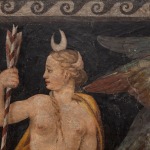-
Biography
Marcello Fogolino (Vicenza, Italy, 1482/1488 – Vicenza, Italy, circa 1559)
Marcello Fogolino was born in Vicenza, likely between 1482 and 1488. As the son of a painter active in Vicenza from 1476 to 1496, he began his career collaborating with Montagna in his workshop before relocating to Venice around 1508–1509.
In 1511, he worked in Padua, where several of his religious commissions are housed, reflecting a clear connection to Montagna’s workshop. Fogolino remained in Venice for eight years, returning to Vicenza in 1515. Although little is known about his travels, it is possible he visited Central Italy and Rome during his time in Venice, given his familiarity with Classical art.
He continued to work in the Vicenza area, frequently intersecting with Montagna. During this period, he completed the Pagliarini altarpiece, showcasing his distinctive skills, from meticulous micrography to clear stylistic details that balance minute observation with overall composition. Establishing himself within the Vicenza art scene, often depicted in his works, Fogolino received numerous commissions, predominantly religious in nature, that indelibly marked his presence in the city.
In 1525, he was in Vicenza with his brother, where they were paid with a plot of land and a house for a now-lost altarpiece depicting the Trinity. Fogolino continued to work in the area, producing a Nativity for the church of Saints Faustino and Giovita in Vicenza.
That same year, he returned with his brother to Friuli, where in 1526 they were both accused of the murder of a barber from Belgrado di Varmo. Instead of appearing in court in Udine, the brothers fled to Trento, where they were banished from the Republic of Venice in 1527.
Entering the circle of the Prince-Bishop of Trento, since 1531 Fogolino was involved in the decoration of the Buonconsiglio Castle with Dosso Dossi, Romanino, and other minor artists.
In Trento, he continued to work for the episcopal circle, creating numerous frescoes that have withstood the test of time.
In 1547, he decorated the Bishop’s Palace in Ascoli Piceno, illustrating Moses’ Life with careful attention to architectural and landscape details.As commissions diminished in Trento, Fogolino returned to the graphic production, employing a “pointillistic” technique on classical subjects and sacred or profane episodes.
Photo UniCredit Group (Sebastiano Pellion di Persano)
-
Works
Marcello Fogolino (ambito di) Italian, 1482/1488-1559
Fregio con grottesche e la dea Diana, 1548 ca.Fresco / Affresco / Fresko37 3/8 x 112 5/8 x 3/4 in
95 x 286 x 2 cmPhoto: UniCredit Group (Sebastiano Pellion di Persano)Further images
4of 4
Join our mailing list
* denotes required fields
In order to respond to your enquiry, we will process the personal data you have supplied in accordance with our privacy policy.










